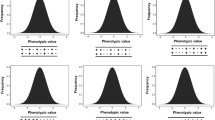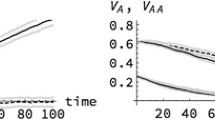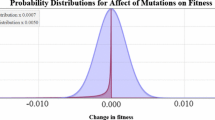Abstract
A pleiotropic model is presented for deriving the equilibrium genetic variance by mutation and stabilizing selection and the long-term genetic responses to directional selection in the case where mutations have pleiotropic effects on fitnes itself (direct deleterious effect) and on a quantitative trait (phenotypic effect). The equilibrium genetic variance is derived as a general form of the rare-alleles models, i.e., \(\tilde V_G = \frac{{2n\mu \alpha ^2 }}{{s_u + \alpha ^2 /(2V_s )}}\), where n is the number of loci, μ is the per-locus mutation rate, \(\alpha ^2 \) is the variance of new mutations, Vs is the measure of stabilizing selection, and su is the selection coefficient on mutations by direct deleterious effect. The genetic responses to directional selection is calculated based on the assumption that the genetic variance is kept at an equilibrium by mutation and stabilizing selection but without directional selection, and the directional selection starts to operate on the target trait. The evolutionary rate at the t-th generation after the introduction of the directional selection is \(\Delta \bar z(t) = i\tilde V_G e^{ - s_T t} \) , where i is the directional selection intensity, and sT is the total selection coefficient on mutations, i.e., \(s_u + \alpha ^2 /(2V_s )\) . The selection limit is\(R = iV_m /s_T^2 \) , where Vm is the mutational variance \((2n\mu \alpha ^2 )\). The pleiotropic effects of genes reduce both the evolutionary rate and the selection limit.
Similar content being viewed by others
References
Ajioka, J.W. & W.F. Eanes, 1989. The accumulation of P elements on the tip of the X chromosomes of Drosophila melanogaster. Genetical Research.53: 1-6.
Barton, N.H., 1990. Pleiotropic models of quantitative variation. Genetics 124: 773-782.
Barton, N.H. & M. Turelli, 1987. Adaptive landscapes, genetic distance, and the evolution of quantitative characters. Genetical Research 49: 157-173.
Barton, N.H. & M. Turelli, 1989. Evolutionary quantitative genetics: how little do we know? Annual Review of Genetics 23: 337-370.
Bulmer, M.G., 1973. The maintenance of the genetic variability of quantitative characters by heterozygote advantage. Genetical Research.22: 9-12.
Bulmer, M.G., 1980. The Mathematical Theory of Quantitative Genetics. Clarendon Press, Oxford.
Caballero, A. & P. Keightley, 1994. A pleiotropic nonadditive model of variation in quantitative traits. Genetics 138: 883-900.
Charlesworth, B., 1990. Mutation-selection balance and the evolutionary advantage of sex and recombination. Genetical Research 55: 199-221.
Charlesworth, B., R. Lande & M. Slatkin, 1982. A neo-Darwinian commentary on macroevolution. Evolution 36: 474-498.
Crow, J.F. & M. Kimura, 1979. Efficiency of truncation selection. Proceedings of National Academy and Sciences USA 76: 396- 399.
Dudley, J.W., 1977. 76 generations of selection for oil and protein percentage in maize. pp. 459-473 in Proceedings of International Conference of Quantitative Genetics, edited by E. Pollak, O. Kempthorne, and T.B. Bailey, Iowa State University, Ames, Iowa, USA.
Falconer, D.S., 1989. Introduction to Quantitative Genetics, 3rd ed. Longman Scientific & Technical, New York.
Kearsey, M.J. & B.W. Barnes, 1970.Variation for metrical characters in Drosophila populations. II.Natural selection. Heredity 25: 11- 21.
Keightley, P.D. & W.G. Hill, 1990. Variation maintained in quantitative traits with mutation-selection balance: pleiotropic side-effects on fitness traits. Proceeding of Royal Society London B 242: 95-100.
Kimura, M., 1965. A stochastic model concerning the maintenance of genetic variability in quantitative characters. Proceedings of National Academy and Sciences USA 54: 731-736.
Kimura, M., 1983. The Neutral Theory of Molecular Evolution. Cambridge University Press, Cambridge.
Kondrashov, A.S., 1982. Selection against harmful mutation in large sexual ans sexual populations. Genetical Research 40: 325-332.
Kondrashov, A.S. & G. Turelli, 1992. Deleterious mutations, apparent stabilizing selection and the maintenance of quantitative variation. Genetics 132: 603-618.
Latter, B.D.H., 1960. Natural selection for an intermediate optimum. Australian Journal of Biological Science 13: 30-35.
Lande, R., 1975. The maintenance of genetic variability by mutation in a polygenic character with linked loci. Genetical Research 26: 221-235.
Lande, R., 1979. Quantitative genetic analysis of multivariate evolution, applied to brain: body size allometry. Evolution 33: 402- 416.
Mackay, T.F.C., 1985. A quantitative genetic analysis of fitness and its components in Drosophila melanogaster. Genetical Research 47: 59-70.
Mackay, T.F.C., 1987. Transposable element-induced polygenic mutations in Drosophila melanogaster. Genetical Research 49: 225-233.
Mackay, T.F.C. & C.H. Langley, 1990. Molecular and phenotypic variation in the achaetescute region of Drosophila melanogaster. Nature 348: 64-66.
Mackay, T.F.C., R. Lyman & M.S. Jackson, 1992a. Effects of P elements on quantitative traits in Drosophila melanogaster. Genetics 130: 315-332.
Roberts, R.C., 1966. The limits to artificial selection for body weight in the mouse. II. The genetic nature of the limits. Genetical Research 8: 361-375.
Robertson, A., 1955. Selection in animals: synthesis. Cold Spring Harbor Symposium Quantitative Biology 20: 225-229.
Robertson, A., 1967. The nature of quantitative genetic variation, pp. 265-280 in ‘Heritage From Mendel’ edited by A. Brink, University of Wisconsin Press, Madison.
Robertson, A., 1968 The spectrum of genetic variation, pp. 5-16, in ‘Population Biology and Evolution’ edited by R.C. Lewontin, Syracuse University Press, Syracuse.
Roff, D.A. & T.A., Mousseau, 1987. Quantitative genetics and fitness: lessons from Drosophila. Heredity 58: 103-118.
Simpson, G.G., 1944. Tempo and Mode in Evolution. Columbia University Press, New York.
Shrimpton, A.E., T.F.C., Mackay & A.J., Leigh Brown, 1990. Transposable element-induced response to artificial selection in Drosophila melanogaster: molecular analysis of selection lines. Genetics 125: 803-811.
Stanley, S.M., 1979. Macroevolution. W.H.Freeman, San Francisco.
Tanaka, Y., 1996. The genetic variance maintained by pleiotropic mutation. Theoretical Population Biology 49: 211-231.
Tanaka, Y., 1998. The dynamics and the selection limit of a quantitative character under weak directional selection with pleiotropic mutation. Theoretical Population Biology (in review).
Turelli, M., 1984. Heritable genetic variation via mutation-selection balance: Lerch's zeta meets the abdominal bristle. Theoretical Population Biology 25: 138-193.
Turelli, M., 1988. Population genetic models for polygenic variation and evolution, pp. 601-618 in ‘Proceedings of the Second International Conference on Quantitative Genetics’ edited by B.S. Weir, E.J. Eisen, M.M. Goodman and G. Namkoong, Sinauer, Sunderland, Mass.
Yoo, B.H., 1980a. Long-term selection for a quantitative character in large replicate populations of Drosophila melanogaster. I. Response to selection. Genetical Research 35: 1-17.
Yoo, B.H., 1980b. Long-term selection for a quantitative character in large replicate populations of Drosophila melanogaster. II.Lethals and visible mutants with large effects. Genetical Research 35: 19-31.
Author information
Authors and Affiliations
Rights and permissions
About this article
Cite this article
Tanaka, Y. A pleiotropic model of phenotypic evolution. Genetica 102, 535–543 (1998). https://doi.org/10.1023/A:1017028118368
Issue Date:
DOI: https://doi.org/10.1023/A:1017028118368




